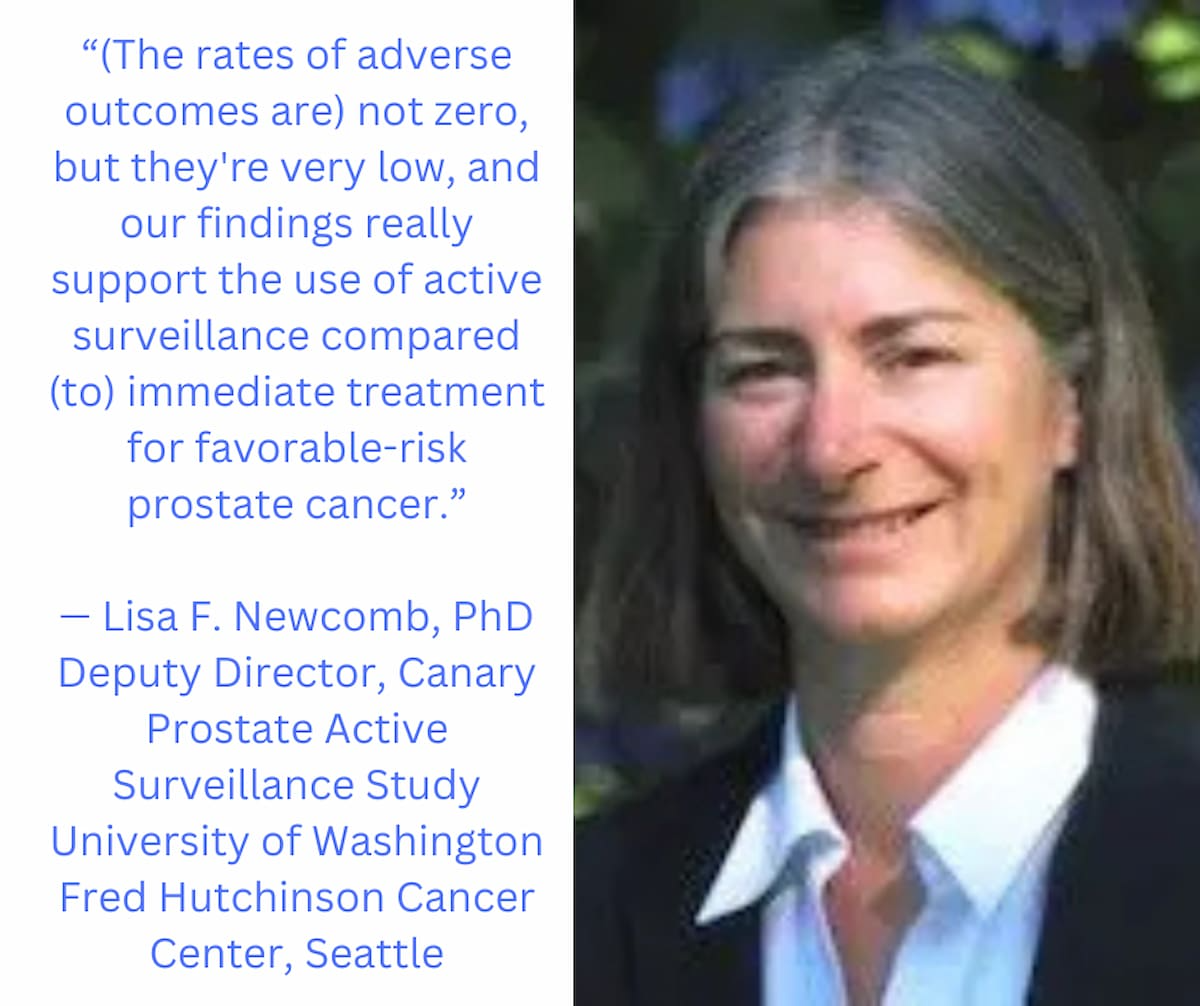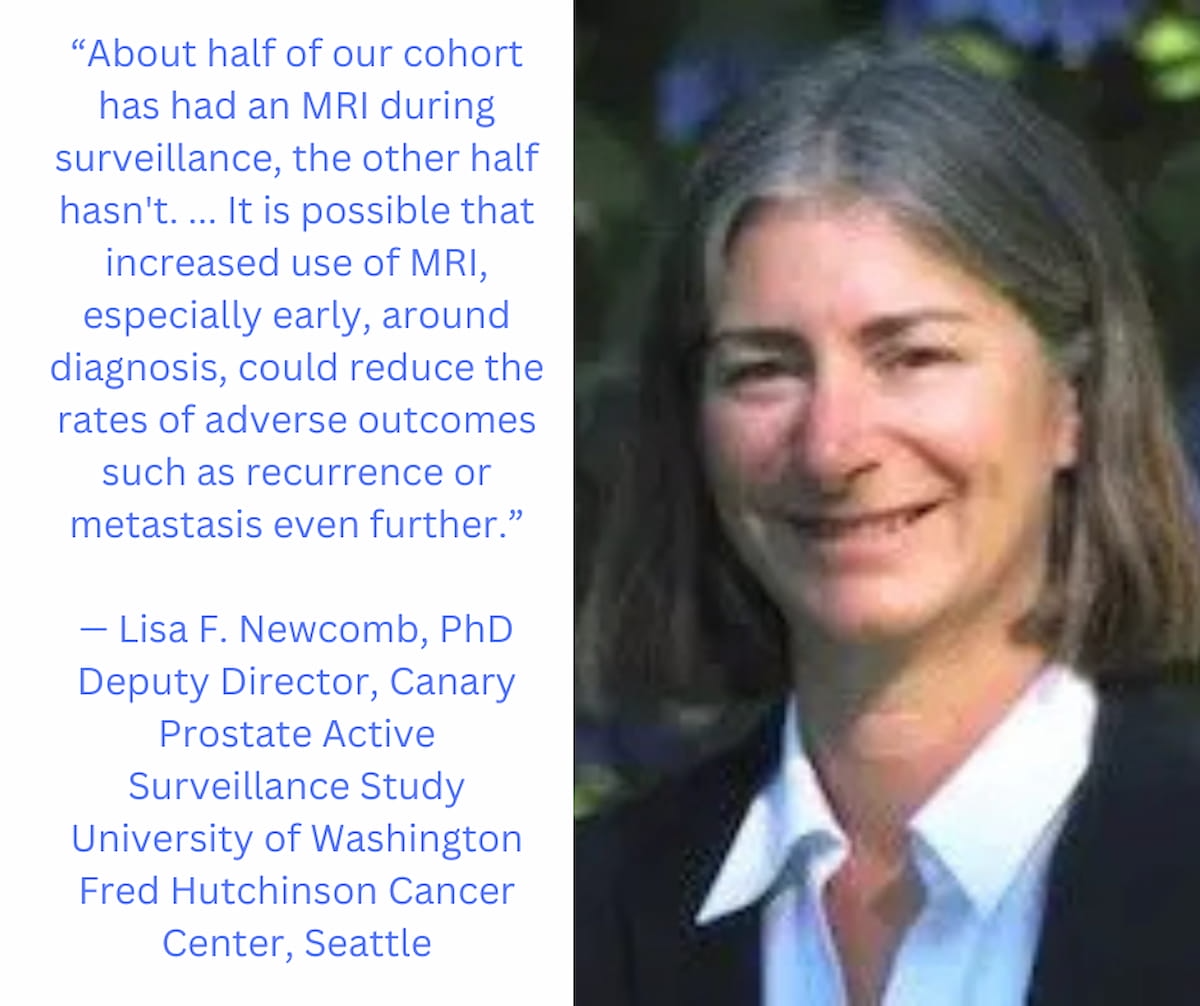Current Concepts in Active Surveillance for Prostate Cancer
In a recent interview, Lisa F. Newcomb, Ph.D., discussed the merits of active surveillance for low-risk prostate cancer (PCa) and key findings from multicenter research involving over 2,100 men with localized PCa.
In a recent long-term study evaluating the use of active surveillance in over 2,100 men with low-risk prostate cancer (PCa), researchers found that nearly half of the study participants had no disease progression a decade after initial diagnosis and less than two percent of the cohort experienced metastatic disease.
The research, recently published in JAMA, demonstrates that long-term active surveillance in men with localized PCa significantly reduces unnecessary biopsies and over-treatment, according to Lisa F. Newcomb, PhD, the deputy director of the Canary Prostate Active Surveillance Study at the University of Washington and Fred Hutchinson Cancer Center in Seattle.
In a recent interview with our sister publication Urology Times, Dr. Newcomb shared her insights from the study.
(This article has been adapted with permission from its original publication in Urology Times.)
Please describe the background for this study.
The Canary Prostate Active Surveillance Study (PASS) is a protocol-directed multicenter study. We're enrolling patients at 10 sites throughout the United States and Canada. The protocol was written and conceived in 2007, and we started enrolling patients in 2008. This was a period when there was a large recognition of overtreatment of indolent prostate cancer that would not cause harm if left untreated. This had come about with the era of prostate-specific antigen (PSA) screening. PSA screening started in the 1990s, and at this time, there were several studies that were starting to show that low-risk prostate cancers would not cause harm if they were left untreated. But 90 percent of low-risk cancers were being treated immediately by radiation or surgery, usually, and so active surveillance was being introduced as a management strategy that mitigates the effects of overtreatment. With active surveillance, participants have PSAs regularly, every six months to a year, periodic prostate biopsies, and more recently, MRI has been incorporated in surveillance protocols. The goal is to avoid treatment if there are no signs of progression, or treat when there are signs of progression, but not before that.

Today, all clinical guidelines recommend active surveillance as a preferred management strategy for favorable-risk or low-risk cancers. But yet, the uptake in the United States is still only about 60 percent for low-risk cancers, and the uptake varies a lot by clinical practice and even by urologists or practitioners within a specific practice. So it was in this setting that we evaluated active surveillance as a long-term management strategy for favorable-risk cancers, and we did this by assessing the outcomes of the 2155 patients who were enrolled in Canary PASS over the past 15 years.
What were some of the notable findings? Were any of them surprising to you and your coauthors?
I think one of the important findings was that at 10 years, about 50% of the men in our cohort had received treatment. This was not surprising. It's pretty in line with many surveillance or monitoring studies. We also found that during the same time frame, less than 2% of participants had developed metastatic cancer, and well less than 1% — 0.2% — had died of their prostate cancer, while during that same time frame, the overall mortality was a little over 5%.
One of the unique and important findings from our study is we looked at the adverse outcomes of men who were treated, reclassified, and then treated at the confirmatory biopsy, or the first biopsy after the diagnostic biopsy. This was a median of one and a half years after prostate cancer diagnosis. We compared them to the men who were treated later during surveillance, so after a median of four and a half years, they received two to three additional surveillance biopsies. We found that there were very similar rates of adverse outcomes. The rate of adverse pathology in the people who received surgery was virtually identical, about 31 percent in both groups. Recurrence after treatment was, again, virtually identical; about 10% of men had their cancer recur within five years after receiving delayed treatment. And, if anything, the rates of metastasis were higher in the people treated early after the confirmatory biopsy. Fourteen of the 21 metastases that occurred in our cohort, which is 75 percent of the metastases, occurred after either upgrading or treatment after the confirmatory biopsy, the first biopsy after diagnosis. So very few of the metastases were recurring later during this surveillance regimen, which we were happily surprised (to see).
What do you consider to be the most significant findings regarding the long-term oncologic outcomes of patients on active surveillance?
The most important finding is that the rates of adverse outcomes that we don't ever want to see are very low. They're not zero, but they're very low, and our findings really support the use of active surveillance compared with immediate treatment for favorable-risk prostate cancer.

How do the results of this study compare with previous research on active surveillance for prostate cancer?
The rates of our adverse outcomes are lower than in many — not all —studies. Comparing studies is difficult. There are several factors that can contribute to rates, such as the enrollment criteria in the study and the follow-up regimens. For example, Canary PASS has broad eligibility criteria. There are no Gleason requirements. There are no PSA requirements. This was deliberately intended to capture all men using active surveillance. In comparison, Johns Hopkins, which has a very well-established active surveillance series, has much stricter eligibility criteria. They have lower risk men in their cohort, and they (have) the one study that has slightly lower rates of metastasis and death than we find.
Another factor that contributes to outcomes in men using surveillance is the follow-up protocol, and Canary PASS does have protocol-directed biopsies, and it has high compliance to those biopsies. In the published work, we had an every-2-year biopsy schedule after that first confirmatory biopsy, which we always recommend within a year after diagnosis. We've recently extended our biopsy schedule to four years, so there's a recognition that a super-stringent biopsy schedule is not necessary, but we do think that the high adherence to surveillance biopsies in our cohort probably contributes to lower rates of adverse outcomes in the long run.
What are some potential limitations of the study, and how might these limitations be addressed in future research?
That's an important question. One of the largest limitations in our study is that our cohort spans the era of multiparametric MRI being introduced into prostate cancer care. We have always collected data on the use of MRI, and we have recently added MRI as a requirement before any biopsy in our protocol. Although about half of our cohort has had an MRI during surveillance, the other half hasn't. And it is possible that increased use of MRI, especially early, around diagnosis, could reduce the rates of adverse outcomes such as recurrence or metastasis even further.
Another limitation of our study is that we only have 7% Black participants in our study, and we have previously published that the rates of upgrading on surveillance biopsies are similar in Black and White men, but larger studies do need to be done to assess the long-term outcomes of Black men (undergoing) active surveillance. Lastly, our median follow-up is 7.2 years, which is longer than most published active surveillance studies. Yet, in the natural history of prostate cancer, it's still relatively short, and I do expect that with more time, we will see more recurrence and metastasis and probably a few more prostate cancer deaths in our cohort.
What are your plans for future research in this area, and how might the results of this study inform future research?
We are really focusing on better stratifying the risk in these favorable-risk diagnoses. We've learned from this study that at least 50% of the men in our cohort do not need as frequent biopsies as they have been receiving, so we're focusing on better ways to identify those men early, so they can be spared the morbidities of biopsies. Likewise, there's about 10% to 15% that have reclassification to grade group 3 or recur after treatment or did metastasize. We would like to identify those men even earlier, so they could be treated earlier. To do both of these techniques of risk stratification, we're looking at a number of biomarkers—tissue based, blood based, urine based. We're doing a deep dive into histologic features such as cribriform. There's a fair amount of evidence that Gleason pattern 4 disease that has cribriform has worse outcomes than pattern 4 that does not have cribriform. We're working with a number of companies to evaluate AI strategies for histology and for MR imaging.
What would you say is the take home message of the paper?
These prostate cancers that are diagnosed as grade group 1, many of the grade group 2, PSA levels less than 10 to 20 (ng/mL), do not need immediate treatment. They can safely be surveilled with regular PSA, periodic biopsies, and periodic MRI, and only treated if there's signs of progression.
Is there anything you would like to add?
My hope is that the results of our study improve the uptake of active surveillance, further reducing unnecessary treatments, and this, combined with the improving reflex tests, may change the risk-benefit of PSA screening. I really hope that there is more uptake of PSA screening. With the U.S. Preventive Services Task Force recommendations of a D and now a C rating for PSA screening, there has been increasing rates of metastasis and mortality. PSA is not a perfect biomarker. It lacks specificity, but it is the most available early-detection biomarker for prostate cancer. I would like to see a greater use of PSA screening.
Reference
1. Newcomb LF, Schenk JM, Zheng Y, et al. Long-term outcomes in patients using protocol-directed active surveillance for prostate cancer. JAMA. 2024;331(24):2084-2093. doi:10.1001/jama.2024.6695
New bpMRI Study Suggests AI Offers Comparable Results to Radiologists for PCa Detection
April 15th 2025Demonstrating no significant difference with radiologist detection of clinically significant prostate cancer (csPCa), a biparametric MRI-based AI model provided an 88.4 percent sensitivity rate in a recent study.
Expanded FDA Approval Allows Use of Pluvicto Prior to Chemotherapy in Patients with mCRPC
March 28th 2025Recent research demonstrated a 59 percent reduced risk of progression or death with the radioligand therapy Pluvicto in comparison to a change of androgen receptor pathway inhibitor (ARPI) for patients with metastatic castration-resistant prostate cancer (mCRPC).
Study: Monitoring of Prostate MRI Exams Could Lead to 75 Percent Reduction of Gadolinium Contrast
March 17th 2025While DCE MRI was deemed helpful in over 67 percent of cases in which it was used, researchers found that monitored prostate MRI exams, which facilitated a 75 percent reduction of DCE MRI sequences, had comparable sensitivity for prostate cancer as non-monitored exams.